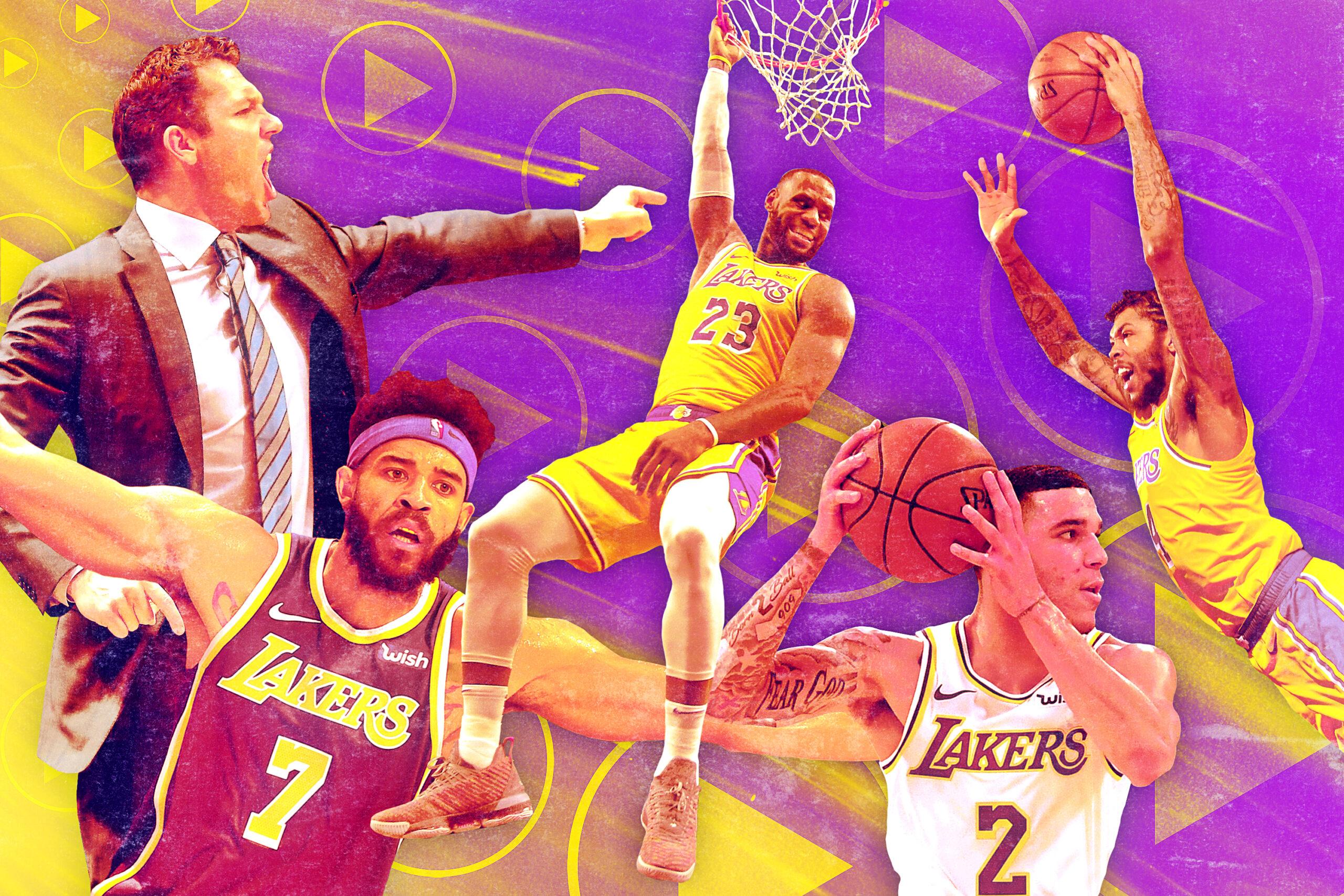
Establishing a tempo is at the top of every team’s game plan, but they usually hold off until after the opening tip to start trying. The Los Angeles Lakers aren’t waiting anymore. They made that message clear on the very first play of LeBron James’s very first preseason game.
As soon as JaVale McGee flicked the jump ball toward his backcourt, the center immediately darted down the middle of the court, past Denver’s unsuspecting defense, and toward the Lakers’ hoop. Rajon Rondo corralled the rebound and lofted up an alley-oop pass. McGee was moving so fast he nearly overran his own goal, but he guided the ball through the rim, giving the Lakers an unusually early two-point lead. Twelve seconds had come off the clock.
The Lakers have tried to pull off the trick after every tipoff McGee wins, catching both the Suns and the Mavs off guard through their first 10 games. (The Rockets, Raptors, and Spurs sniffed it out. Go figure.) They attempted it again in Wednesday night’s matchup against the Minnesota Timberwolves, already the Lakers’ 10th nationally broadcast game in the 17 they’ve played between the preseason and regular season. Minnesota, the NBA’s 29th-ranked defense, didn’t get the memo.
McGee missed, as he did against Dallas one week prior, but the ball didn’t stop pinging from there. Less than a minute later, Lonzo Ball hit Brandon Ingram with a cross-court assist. The Wolves pushed it right back, leading to an authoritative dunk from Karl-Anthony Towns. LeBron then went right back at the Wolves, gliding to a transition layup.
With the game hanging in the balance, and the Staples Center atmosphere providing the league’s best backdrop for theater, the Lakers’ performance started to look more like volleyball. Up one with 46 seconds to play, James stepped back and reeled off a 3-pointer 2 feet behind the line; he missed, but was saved by a Tyson Chandler rebound. James set up Kyle Kuzma for a wide-open 3 from the corner; he missed, but was saved by another rebound. James again tried to pull up from 3, this time from 5 feet out; he missed once again, but once again was saved by a Chandler rebound.
Kuzma was fouled and split the free throws, giving the Wolves one last chance at a second win over Los Angeles in the past nine days. The Lakers’ porous defense even allowed Derrick Rose, who led Minnesota with 31 points on the night, a clean look at a potential game-winner from the top of the arc. But the ball rimmed out and into the quick hands of Josh Hart, securing the Lakers’ fifth win of the season.
It was an appropriate ending for the most entertaining team in the NBA: The Lakers may not know how to win with any consistency yet, but they do know drama.
The NBA, when boiled down to its most basic, is a Venn diagram. You have good teams. You have bad teams. And when the two intersect, you have the most essential of them all: League Pass teams.
The middle was once thought of as a death sentence. Superstar players dictate the fate of the NBA more than they do in other team sports, and if you didn’t have one, or a lottery ticket to get one, the thinking was your franchise was paralyzed in the organizational purgatory known as the Treadmill of Mediocrity. That still may be the case from a team-building perspective. The Indiana Pacers and Portland Trail Blazers have pushed the theory’s limits by succeeding with lower-tier centerpieces, but it’s impossible to discuss either of them, or the likes of the Miami Heat and the Los Angeles Clippers, without being drowned out by an internal voice of doubt that asks, “But how will they land another star?” Being good is good enough for only so long; no team wants to be the Joe Johnson Hawks when they grow up.
But the middle also has all the intrigue. It’s where the hope of a rebuilding team crashes head first into the real-world expectations set by the league’s elite. It’s where the bottom of the pool drops out and a team is forced to sink or swim. A bad team often has a few new prospects to track—ESPN broadcast the first matchups between Luka Doncic and Deandre Ayton (on the second day of the season!), and Doncic and Trae Young—but fatalism sets in around the All-Star break and lineups turn into G League showcases. A good team will play well-executed basketball, which is always nice, but the regular-season stakes ultimately dwindle to seedings and playoff prep work, sucking out any dramatic tension along with them. The Warriors’ biggest adversary coming into the season was not the Boston Celtics, it was ennui.
On the last night of the 2017-18 regular season, the Houston Rockets, winners of a league-best 65 games, sat four of their best players and put up 83 points on the lowly Sacramento Kings. Later that same night, two high-40-win teams, the Nuggets and Timberwolves, held a de facto play-in game that took overtime to settle. The middle may not matter in the championship picture, but much like a burrito, it’s where all the interesting stuff is.
No team in recent history represents that better than the LeBron Lakers. Virtually every game of James’s maiden voyage in L.A. has begun as a toss-up and finished as a heart attack. The Lakers have fallen into “clutch” territory—within five points in the final five minutes and the final two minutes—in nine of their 11 games this season, and traded leads with their opponent more than 10 times in five games, including 20 times in their home opener against the Rockets, 20 more on Wednesday, and a whopping 22 times last week in Minnesota. Six games have been decided by four points or fewer, and their net rating, point differential, and record are stuck, much like their season, in neutral: minus-0.3, minus-0.7, 5-6. James may be the league’s ultimate stabilizer; he legally wouldn’t have been able to drink one of his choice bottles of cabernet sauvignon the last time one of his teams missed the playoffs. Yet virtually every game he’s played with the Lakers so far has been a white-knuckler, and, heightening the drama even more, all but one has been scheduled at the end of the night like a title bout.
Even the blowouts have been captivating. With Kawhi Leonard sitting out because of a foot injury, Sunday’s game against the Raptors was the perfect opportunity for the Lakers to show off their wares to the disgruntled superstar, like an episode of Cribs. (“Over here is our vintage pass-first point guard. Very hard to find.”) But it melted down into a rubbernecker’s oasis as the Leonard-less Raptors DDT’d the home team in the first quarter, 42-17. It was a frustrating—and historic—outcome for a franchise with a voracious appetite for star power, but an encouraging sign that not even James’s high approval rating can diminish one of sports’ purest moments of satisfaction: Lakers schadenfreude. And then they came back! A deficit that at one point crept into the 30s was chopped down to 10 with just over two minutes to go, all with James watching from the bench. The Lakers lost, but it was easily the best worst game of the young season.
One night earlier, the fourth-quarter rush went the other way. With reports of Magic Johnson’s dissatisfaction in coach Luke Walton looming over them in Portland, the Lakers let a 20-point lead with about nine minutes to play deteriorate down the stretch. When 20 points became 14 points, the unease among the Lakers’ broadcast crew was palpable. Oh, no. Not again. The lead dropped all the way down to four with 10.6 seconds left, and may have flipped entirely if not for a wide receiver’s toe tap from Josh Hart to save a near turnover.
Most of the entertainment value is baked right into the way the Lakers play. They rank third in the league in pace, at a time when the game moves faster than it has in three decades. These aren’t your slightly older sibling’s Lakers; Walton’s offense is cramming in nearly 15 more possessions per 48 minutes than Phil Jackson did in his last season at the helm nine years ago. That means more shots are getting up, more points are being scored, and more bodies are in motion. Rob Pelinka and Johnson’s vision for prioritizing playmaking over shooting hasn’t exactly revolutionized the game, but the amount of plus passers they can throw on the court at once has created an offense that can look more like a soccer team screaming down the pitch. On one possession early in the third quarter of an early November game in Portland, Brandon Ingram passed out of a postup to James, a 33-year-old high-usage superstar darting down the lane on an off-ball cut like he was Draymond Green. When the defense stepped up in the paint to prevent the oncoming rush, James ducked the ball underneath their arms and dumped it off to JaVale McGee for an easy dunk. This stuff happens multiple times a game:
When the passes hit their targets, the orchestration can be as pretty as a crisply run triple-option play. (The Lakers’ ability to create points off a pass is elite.) When the passes miss, the chaos it creates is just as compelling. After the Brandon Ingram–Lonzo Ball–McGee hockey assist above, McGee wasted a strong contest on defense by starting the break a step behind James:
The tight games make each possession a bit more important, which raises the will-they/won’t-they drama of every pass attempted through a tight window and every 3-pointer they toss up. When they’re off the mark—and they are more often than most teams—it creates a scramble back the other way.
The Lakers can’t stop anyone on the other end; McGee, who a week ago conducted a postgame interview in a Grinch costume tailored to his 7-foot frame, has become one of their most important players because he’s the only one willing to put up a fight at the rim. But they do make a show of it. The open driving lanes often lead to a collision with McGee at the basket, which he’s winning more often than you’d think. And while the nuances of switching are still a work in progress, their young players are willing to throw their bodies around to compensate; Hart should probably play in a leather helmet at this point. The Lakers don’t have size, but they scrap. (And when push comes to shove, they spit.) Lakers ownership has always projected old money, even in the recent lean years, but the visual cues on the court this season are, ironically, that of an underdog.
That clash of old and new, tradition and fresh start has already drawn out some fun tricks from the basketball seniors the Lakers signed this offseason. In addition to McGee’s emergence as a block-thirsty demogorgon, James has been more willing to try on a Steph Curry costume every now and then. As a nominal big in some lineups, he’s forced to move without the ball more, and he also appears more comfortable jacking 3-pointers from deep range: Through 11 games, James has attempted five shots from 30 feet or more, which is nearly half as many as he took in 82 appearances last season. The downside is James has been prone to idle around the arc and watch over the young’uns like a retired legend at a fantasy camp. He’s also very online these days, but there’s a certain appeal to that, too. We haven’t reached Fit In/Out territory yet, but the Lakers’ social media has become a worthy second-screen experience to the drama unfolding in real time.
James is an accelerant to everything he touches. That has been a boon on the court: the Lakers offense is now just as efficient as the Cavaliers’ was last season. But a big-market team already notorious for palace intrigue—six years ago, the franchise’s lead decision-maker refused to rehire his sister’s boyfriend as head coach—has seen its daily telenovela amplified to new levels. Think back to the Lakers’ games from this weekend. There’s no reason a back-to-back in early November against the Blazers and the Raptors should carry much significance. That certainly wasn’t the case last season, when the Lakers had less than half as many wins as losses by January 1. But the burden of expectation is one of the taxes of any partnership with James; given how fast the news cycle moves, and how crucial James is to keeping the content wheels turning, that burden often materializes before each and every game. That’s how Game 9 on a Saturday night in Portland can become a referendum on Walton’s coaching style, or how Game 10 can become an audition for a superstar who may want to join them eight months from now.
This roster and this playing style would rate highly on anyone’s watchability rankings, no matter what team name was written across the jerseys. (Though the aesthetics are elite in their own rights.) But the Lakers take everything entertaining about the NBA’s middle class and pile on all the pressure to succeed of a blue-blood franchise, all the promise of a team building through the draft, and all the melodrama of a LeBron James team. And every so often, the camera will cut to a closeup of the players and you remember that McGee unabashedly sports a multipronged rat tail and has a mouth guard made to look like gold fronts. What’s not to love?

